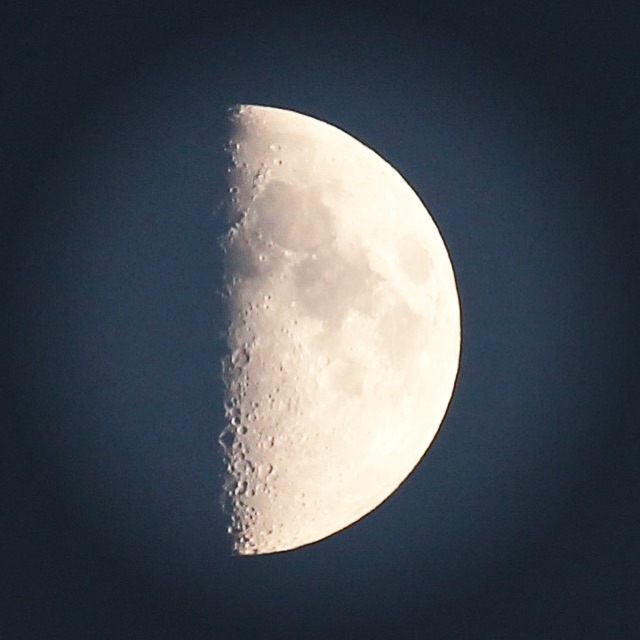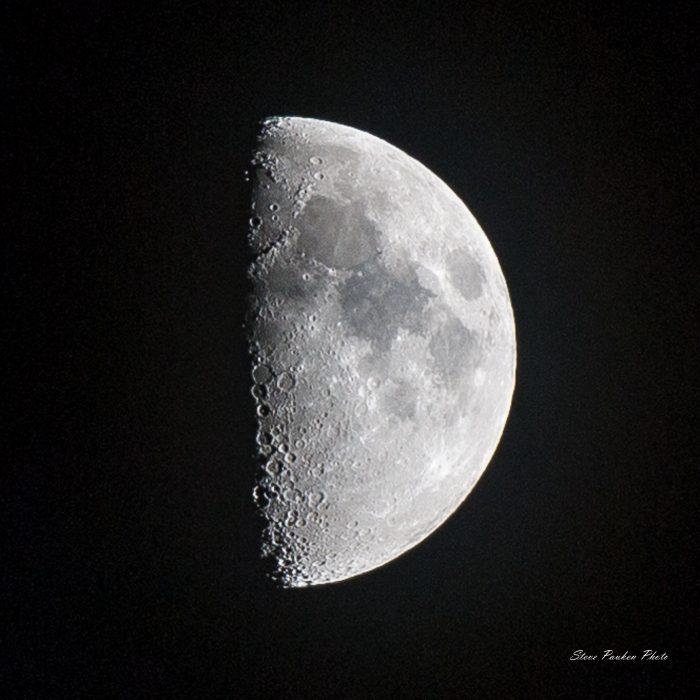

July 27, 2020, first quarter moon via EarthSky friend Chili Dcpa. Thanks, Chili!
People sometimes look up and say:
Is that a ‘half’ moon in the sky?
Astronomically, the answer to that question is always no. There’s no half-moon phase, at least not in any official way. Invariably, when referring to a half moon, observers are looking at a quarter moon. You see a moon that looks half-illuminated, like half a pie. It might be first or last quarter moon, but – to astronomers – never a half moon. Why is that?
Let’s talk for a minute about the names for the various moon phases. A new moon is most nearly between the Earth and sun for any given lunar orbit. At such a time, the the moon is considered by astronomers to have entered a new orbital cycle, called a lunation.
Full moon signifies that the full visible surface of the moon – its day side – is fully turned toward Earth.
First quarter moon means we see half of the moon’s day side (a quarter of the whole moon), and the moon is one quarter of the way through the current orbital cycle.
Third or last quarter moon means we see a quarter of the moon’s day side, and the moon is three-quarters of the way through the cycle, as measured from one new moon to the next.
Just realize this. Astronomers recognize four primary moon phases (new, first quarter, full, last quarter) and four interstitial phases (waxing crescent, waxing gibbous, waning gibbous waning crescent). Notice … no half moon.

EarthSky friend Steve Pauken caught the 1st quarter moon on July 27, 2020, too, from Bisbee, Arizona. Thank you, Steve! See how the terminator line – or line between light and dark on the moon – is straight, dividing the illuminated from the shadowed side of the moon.
People frequently speak of half moons. There are geographical locations (e.g., Half Moon Bay in California), as well as restaurants, resorts and various other attractions and businesses with this moniker.
And so you see that the process of naming things in astronomy isn’t always logical, except perhaps in a very narrow sense. You may think that heavy metal refers to gold or lead, or your favorite band. But, in astronomy, a metal is means any element – even some that normally are gases on Earth – that’s anything other than the two lightest elements, hydrogen and helium. Oxygen and carbon, for example, are metals in the language of astronomers. Seriously.
Or consider the ad hoc definition of a dwarf planet adopted by the International Astronomical Union, and used to dump Pluto, unceremoniously, from full planethood. Astronomers are scientists, and, like all scientists, they use a jargon all their own.
In a couple of senses, though, every time you view the moon, you’re observing a half moon. First, just half the moon always faces us. You can’t see the back side since it’s always turned away from us.
Second, whether you can see it all or not, one half of the entire moon is always illuminated by the sun. In other words, the moon has a dayside, just as Earth does. We see this illuminated half of the moon – the entire dayside of the moon – only at full moon.
By the way, there are some other moon phases that are less well known. The moon is named for its shape, which can be a waxing crescent (growing) or waning crescent (diminishing). And we also have gibbous moons, indicating a shape that is unequally curved outward on both sides, but not full. Gibbous moons also wax and wane depending on its time in the cycle.

Click here to see animation. As seen from the north side of the moon’s orbital plane, the Earth rotates counterclockwise on its rotational axis, and the moon revolves counterclockwise around Earth. The terminators of the Earth and moon align at first and last quarter moons, and only the near half of the moon’s day side is visible from Earth.
Learn much more about the various phases of the moon at EarthSky’s article Four keys to understanding moon phases.
Bottom line: You might consider it just a play on words or an oddity of language, but, in the astronomy vocabulary, there are no half moons.
from EarthSky https://ift.tt/3lr0v5g


July 27, 2020, first quarter moon via EarthSky friend Chili Dcpa. Thanks, Chili!
People sometimes look up and say:
Is that a ‘half’ moon in the sky?
Astronomically, the answer to that question is always no. There’s no half-moon phase, at least not in any official way. Invariably, when referring to a half moon, observers are looking at a quarter moon. You see a moon that looks half-illuminated, like half a pie. It might be first or last quarter moon, but – to astronomers – never a half moon. Why is that?
Let’s talk for a minute about the names for the various moon phases. A new moon is most nearly between the Earth and sun for any given lunar orbit. At such a time, the the moon is considered by astronomers to have entered a new orbital cycle, called a lunation.
Full moon signifies that the full visible surface of the moon – its day side – is fully turned toward Earth.
First quarter moon means we see half of the moon’s day side (a quarter of the whole moon), and the moon is one quarter of the way through the current orbital cycle.
Third or last quarter moon means we see a quarter of the moon’s day side, and the moon is three-quarters of the way through the cycle, as measured from one new moon to the next.
Just realize this. Astronomers recognize four primary moon phases (new, first quarter, full, last quarter) and four interstitial phases (waxing crescent, waxing gibbous, waning gibbous waning crescent). Notice … no half moon.

EarthSky friend Steve Pauken caught the 1st quarter moon on July 27, 2020, too, from Bisbee, Arizona. Thank you, Steve! See how the terminator line – or line between light and dark on the moon – is straight, dividing the illuminated from the shadowed side of the moon.
People frequently speak of half moons. There are geographical locations (e.g., Half Moon Bay in California), as well as restaurants, resorts and various other attractions and businesses with this moniker.
And so you see that the process of naming things in astronomy isn’t always logical, except perhaps in a very narrow sense. You may think that heavy metal refers to gold or lead, or your favorite band. But, in astronomy, a metal is means any element – even some that normally are gases on Earth – that’s anything other than the two lightest elements, hydrogen and helium. Oxygen and carbon, for example, are metals in the language of astronomers. Seriously.
Or consider the ad hoc definition of a dwarf planet adopted by the International Astronomical Union, and used to dump Pluto, unceremoniously, from full planethood. Astronomers are scientists, and, like all scientists, they use a jargon all their own.
In a couple of senses, though, every time you view the moon, you’re observing a half moon. First, just half the moon always faces us. You can’t see the back side since it’s always turned away from us.
Second, whether you can see it all or not, one half of the entire moon is always illuminated by the sun. In other words, the moon has a dayside, just as Earth does. We see this illuminated half of the moon – the entire dayside of the moon – only at full moon.
By the way, there are some other moon phases that are less well known. The moon is named for its shape, which can be a waxing crescent (growing) or waning crescent (diminishing). And we also have gibbous moons, indicating a shape that is unequally curved outward on both sides, but not full. Gibbous moons also wax and wane depending on its time in the cycle.

Click here to see animation. As seen from the north side of the moon’s orbital plane, the Earth rotates counterclockwise on its rotational axis, and the moon revolves counterclockwise around Earth. The terminators of the Earth and moon align at first and last quarter moons, and only the near half of the moon’s day side is visible from Earth.
Learn much more about the various phases of the moon at EarthSky’s article Four keys to understanding moon phases.
Bottom line: You might consider it just a play on words or an oddity of language, but, in the astronomy vocabulary, there are no half moons.
from EarthSky https://ift.tt/3lr0v5g

Aucun commentaire:
Enregistrer un commentaire